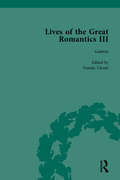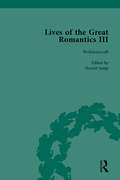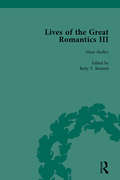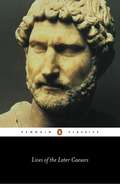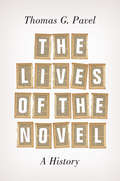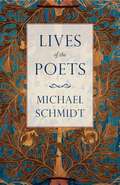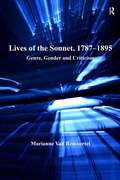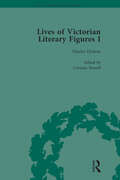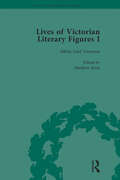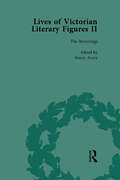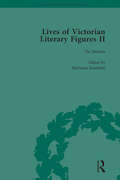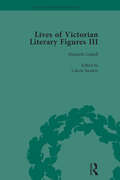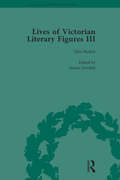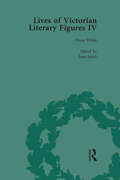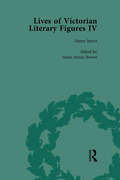- Table View
- List View
Lives of the Great Romantics, Part III, Volume 1
by Pamela ClemitThis volume sheds light on contemporary perception of William Godwin, Mary Wollstonecraft and Mary Shelley, a biographically and intellectually compelling literary family of the Romantic period. The writings reveal the personalities of the subjects, and the motives and agendas of the biographers.
Lives of the Great Romantics, Part III, Volume 2
by Harriet Devine Jump Pamela Clemit Betty T Bennett John MullanThis volume sheds light on contemporary perception of William Godwin, Mary Wollstonecraft and Mary Shelley, a biographically and intellectually compelling literary family of the Romantic period. The writings reveal the personalities of the subjects, and the motives and agendas of the biographers.
Lives of the Great Romantics, Part III, Volume 2
by Harriet Devine Jump Pamela Clemit Betty T Bennett John MullanThis volume sheds light on contemporary perception of William Godwin, Mary Wollstonecraft and Mary Shelley, a biographically and intellectually compelling literary family of the Romantic period. The writings reveal the personalities of the subjects, and the motives and agendas of the biographers.
Lives of the Great Romantics, Part III, Volume 3
by Harriet Devine Jump Pamela Clemit Betty T Bennett John MullanThis volume sheds light on contemporary perception of William Godwin, Mary Wollstonecraft and Mary Shelley, a biographically and intellectually compelling literary family of the Romantic period. The writings reveal the personalities of the subjects, and the motives and agendas of the biographers.
Lives of the Great Romantics, Part III, Volume 3
by Harriet Devine Jump Pamela Clemit Betty T Bennett John MullanThis volume sheds light on contemporary perception of William Godwin, Mary Wollstonecraft and Mary Shelley, a biographically and intellectually compelling literary family of the Romantic period. The writings reveal the personalities of the subjects, and the motives and agendas of the biographers.
Lives of the Later Caesars: Augustan History, With Newly Compiled Lives Of Nerva And Trajan
by Anthony Birley Antony BirleyOne of the most controversial of all works to survive from ancient Rome, the Augustan History is our main source of information about the Roman emperors from 117 to 284 AD. Written in the late fourth century by an anonymous author, it is an enigmatic combination of truth, invention and humour. This volume contains the first half of the History, and includes biographies of every emperor from Hadrian to Heliogabalus - among them the godlike Marcus Antonius and his grotesquely corrupt son Commodus. The History contains many fictitious (but highly entertaining) anecdotes about the depravity of the emperors, as the author blends historical fact and faked documents to present our most complete - albeit unreliable - account of the later Roman Caesars.
The Lives of the Novel: A History
by Thomas G. PavelThis is a bold and original original history of the novel from ancient Greece to the vibrant world of contemporary fiction. In this wide-ranging survey, Thomas Pavel argues that the driving force behind the novel's evolution has been a rivalry between stories that idealize human behavior and those that ridicule and condemn it. Impelled by this conflict, the novel moved from depicting strong souls to sensitive hearts and, finally, to enigmatic psyches. Pavel analyzes more than a hundred novels from Europe, North and South America, Asia, and beyond, resulting in a provocative reinterpretation of its development. According to Pavel, the earliest novels were implausible because their characters were either perfect or villainous. In the eighteenth and nineteenth centuries, novelists strove for greater credibility by describing the inner lives of ideal characters in minute detail (as in Samuel Richardson's case), or by closely examining the historical and social environment (as Walter Scott and Balzac did). Yet the earlier rivalry continued: Henry Fielding held the line against idealism, defending the comic tradition with its flawed characters, while Charlotte Brontë and George Eliot offered a rejoinder to social realism with their idealized vision of strong, generous, and sensitive women. In the twentieth century, modernists like Proust and Joyce sought to move beyond this conflict and capture the enigmatic workings of the psyche. Pavel concludes his compelling account by showing how the old tensions persist even within today's pluralism, as popular novels about heroes coexist with a wealth of other kinds of works, from satire to social and psychological realism.
Lives of the Poets: The History Of Poets And Poetry (Great Lives)
by Michael SchmidtA stunning volume of epic breadth which connects the lives and works of over 300 English-language poets of the last 700 years. LIVES OF THE POETS traverses the landscapes of biography, form, cultural pressures and important historical moments to tell not just a history of English poetry, but the story of English as a language. 'Astonishing' New York Times. 'Deft critical judgements, lightness of touch, the ability both to examine minutely and to generalize boldly – this book is both a tonic and a continuing pleasure' Independent. 'A celebration of poetry in the shape of a history from Chaucer up to the present day. A book to put into the hands of any young man or woman beginning to be aware that poetry is the glory of our language' Scotsman. 'A masterly exercise of cogency and compression' Times Literary Supplement.
Lives of the Sonnet, 1787–1895: Genre, Gender and Criticism
by Marianne Van RemoortelIn a series of representative case studies, Marianne Van Remoortel traces the development of the sonnet during intense moments of change and stability, continuity and conflict, from the early Romantic period to the end of the nineteenth century. Paying particular attention to the role of the popular press, which served as a venue of innovation and as a site of recruitment for aspiring authors, Van Remoortel redefines the scope of the genre, including the ways in which its development is intricately related to issues of gender. Among her subjects are the Della Cruscans and their primary critic William Gifford, the young Samuel Taylor Coleridge and his circle, Elizabeth Barrett Browning's Sonnets from the Portuguese, George Meredith's Modern Love, Dante Gabriel Rossetti's House of Life and Augusta Webster's Mother and Daughter. As women became a force to be reckoned with among the reading public and the writing community, the term 'sonnet' often operated as a satirical label that was not restricted to poetry adhering to the strict formalities of the genre. Van Remoortel's study, in its attentiveness to the sonnet's feminization during the late eighteenth century, offers important insights into the ways in which changing attitudes about gender and genre shaped critics' interpretations of the reception histories of nineteenth-century sonnet sequences.
Lives of the Sonnet, 1787–1895: Genre, Gender and Criticism
by Marianne Van RemoortelIn a series of representative case studies, Marianne Van Remoortel traces the development of the sonnet during intense moments of change and stability, continuity and conflict, from the early Romantic period to the end of the nineteenth century. Paying particular attention to the role of the popular press, which served as a venue of innovation and as a site of recruitment for aspiring authors, Van Remoortel redefines the scope of the genre, including the ways in which its development is intricately related to issues of gender. Among her subjects are the Della Cruscans and their primary critic William Gifford, the young Samuel Taylor Coleridge and his circle, Elizabeth Barrett Browning's Sonnets from the Portuguese, George Meredith's Modern Love, Dante Gabriel Rossetti's House of Life and Augusta Webster's Mother and Daughter. As women became a force to be reckoned with among the reading public and the writing community, the term 'sonnet' often operated as a satirical label that was not restricted to poetry adhering to the strict formalities of the genre. Van Remoortel's study, in its attentiveness to the sonnet's feminization during the late eighteenth century, offers important insights into the ways in which changing attitudes about gender and genre shaped critics' interpretations of the reception histories of nineteenth-century sonnet sequences.
Lives of Victorian Literary Figures, Part I, Volume 2: George Eliot, Charles Dickens and Alfred, Lord Tennyson by their Contemporaries
by Ralph Pite Gail Marshall Corinna RussellCollected here are the biographies which revealed aspects of their subjects that the more favourable "official" accounts tended to hide. The life of the author of each text is described, and their relation to the writers they portray is sketched in.
Lives of Victorian Literary Figures, Part I, Volume 2: George Eliot, Charles Dickens and Alfred, Lord Tennyson by their Contemporaries
by Ralph Pite Gail Marshall Corinna RussellCollected here are the biographies which revealed aspects of their subjects that the more favourable "official" accounts tended to hide. The life of the author of each text is described, and their relation to the writers they portray is sketched in.
Lives of Victorian Literary Figures, Part I, Volume 3: George Eliot, Charles Dickens and Alfred, Lord Tennyson by their Contemporaries
by Matthew Bevis Ralph Pite Gail Marshall Corinna RussellCollected here are the biographies which revealed aspects of their subjects that the more favourable "official" accounts tended to hide. The life of the author of each text is described, and their relation to the writers they portray is sketched in.
Lives of Victorian Literary Figures, Part II, Volume 1: The Brownings (Lives of Victorian Literary Figures)
by Simon AveryThe three volumes that comprise this set are facsimile reproductions of contemporary biographical material. They include letters, memoirs, poems and articles on three outstanding Victorian literary partnerships. These are the Brownings, Brontes and the Rossettis.
Lives of Victorian Literary Figures, Part II, Volume 1: The Brownings (Lives of Victorian Literary Figures)
by Simon AveryThe three volumes that comprise this set are facsimile reproductions of contemporary biographical material. They include letters, memoirs, poems and articles on three outstanding Victorian literary partnerships. These are the Brownings, Brontes and the Rossettis.
Lives of Victorian Literary Figures, Part II, Volume 2: The Brontës
by Marianna KambaniThe three volumes that comprise this set are facsimile reproductions of contemporary biographical material. They include letters, memoirs, poems and articles on three outstanding Victorian literary partnerships. These are the Brownings, Brontes and the Rossettis.
Lives of Victorian Literary Figures, Part II, Volume 2: The Brontës
by Marianna KambaniThe three volumes that comprise this set are facsimile reproductions of contemporary biographical material. They include letters, memoirs, poems and articles on three outstanding Victorian literary partnerships. These are the Brownings, Brontes and the Rossettis.
Lives of Victorian Literary Figures, Part III, Volume 1: Elizabeth Gaskell, the Carlyles and John Ruskin
by Valerie Sanders Aileen Christianson Simon Grimble Sheila A Mcintosh Ralph PiteElizabeth Gaskell, like her contemporary Emily Bronte, was from the north of England, though based in Lancashire and Cheshire rather than Yorkshire. Her first novel, Mary Barton (1848) was set in the north and was unusually realistic in its depiction of Manchester working-class life. Ruskin grew up in suburban London; in later life, he settled in the Lake District . Thomas and Jane Welsh Carlyle moved in the opposite direction - from rural Scotland to London's Cheyne Walk. This title focuses on writers for whom 'the centre' was a pressing concern. The three volumes that comprise a set are facsimile reproductions of contemporary biographical material. They include letters, memoirs, poems and articles on three outstanding Victorian literary persons: John Ruskin, Elzabeth Gaskell and the Carlyles.
Lives of Victorian Literary Figures, Part III, Volume 1: Elizabeth Gaskell, the Carlyles and John Ruskin
by Valerie Sanders Aileen Christianson Simon Grimble Sheila A Mcintosh Ralph PiteElizabeth Gaskell, like her contemporary Emily Bronte, was from the north of England, though based in Lancashire and Cheshire rather than Yorkshire. Her first novel, Mary Barton (1848) was set in the north and was unusually realistic in its depiction of Manchester working-class life. Ruskin grew up in suburban London; in later life, he settled in the Lake District . Thomas and Jane Welsh Carlyle moved in the opposite direction - from rural Scotland to London's Cheyne Walk. This title focuses on writers for whom 'the centre' was a pressing concern. The three volumes that comprise a set are facsimile reproductions of contemporary biographical material. They include letters, memoirs, poems and articles on three outstanding Victorian literary persons: John Ruskin, Elzabeth Gaskell and the Carlyles.
Lives of Victorian Literary Figures, Part III, Volume 3: Elizabeth Gaskell, the Carlyles and John Ruskin
by Ralph Pite Aileen Christianson Simon Grimble Sheila A Mcintosh John MullanRuskin grew up in suburban London; in later life, he settled in the Lake District. Thomas and Jane Welsh Carlyle moved from rural Scotland to London's Cheyne Walk. This title focuses on writers for whom 'the centre' was a pressing concern. Elizabeth Gaskell, like her contemporary Emily Bronte, was from the north of England, though based in Lancashire and Cheshire rather than Yorkshire. Her first novel, Mary Barton 1848) was set in the north and was unusually realistic in its depiction of Manchester working-class life.. The three volumes that comprise a set are facsimile reproductions of contemporary biographical material. They include letters, memoirs, poems and articles on three outstanding Victorian literary persons: John Ruskin, Elzabeth Gaskell and the Carlyles.
Lives of Victorian Literary Figures, Part III, Volume 3: Elizabeth Gaskell, the Carlyles and John Ruskin
by Ralph Pite Aileen Christianson Simon Grimble Sheila A Mcintosh John MullanRuskin grew up in suburban London; in later life, he settled in the Lake District. Thomas and Jane Welsh Carlyle moved from rural Scotland to London's Cheyne Walk. This title focuses on writers for whom 'the centre' was a pressing concern. Elizabeth Gaskell, like her contemporary Emily Bronte, was from the north of England, though based in Lancashire and Cheshire rather than Yorkshire. Her first novel, Mary Barton 1848) was set in the north and was unusually realistic in its depiction of Manchester working-class life.. The three volumes that comprise a set are facsimile reproductions of contemporary biographical material. They include letters, memoirs, poems and articles on three outstanding Victorian literary persons: John Ruskin, Elzabeth Gaskell and the Carlyles.
Lives of Victorian Literary Figures, Part IV, Volume 1: Henry James, Edith Wharton and Oscar Wilde by their Contemporaries
by Ralph Pite Janet Beer Sarah Annes Brown Jane Spirit Elizabeth NolanPart of the "Lives of Victorian Literary Figures" series, this set collects contemporary memoirs, biographies and ephemera relating to Oscar Wilde, Henry James and Edith Wharton. Editorial apparatus includes a general introduction, headnotes, endnotes and a general index.
Lives of Victorian Literary Figures, Part IV, Volume 1: Henry James, Edith Wharton and Oscar Wilde by their Contemporaries
by Ralph Pite Janet Beer Sarah Annes Brown Jane Spirit Elizabeth NolanPart of the "Lives of Victorian Literary Figures" series, this set collects contemporary memoirs, biographies and ephemera relating to Oscar Wilde, Henry James and Edith Wharton. Editorial apparatus includes a general introduction, headnotes, endnotes and a general index.
Lives of Victorian Literary Figures, Part IV, Volume 2: Henry James, Edith Wharton and Oscar Wilde by their Contemporaries
by Ralph Pite Elizabeth Nolan Janet Beer Sarah Annes Jane SpiritPart of the "Lives of Victorian Literary Figures" series, this set collects contemporary memoirs, biographies and ephemera relating to Oscar Wilde, Henry James and Edith Wharton. Editorial apparatus includes a general introduction, headnotes, endnotes and a general index.
Lives of Victorian Literary Figures, Part IV, Volume 2: Henry James, Edith Wharton and Oscar Wilde by their Contemporaries
by Ralph Pite Elizabeth Nolan Janet Beer Sarah Annes Jane SpiritPart of the "Lives of Victorian Literary Figures" series, this set collects contemporary memoirs, biographies and ephemera relating to Oscar Wilde, Henry James and Edith Wharton. Editorial apparatus includes a general introduction, headnotes, endnotes and a general index.
